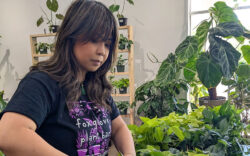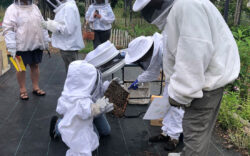The temps are up, and the bugs are out! Holes in your backyard goodies might make you want to kill all the bugs, but hold that spray—most non-chemical solutions are simple. I pluck off, squish and hose down most of my plants when I see the beginnings of an infestation. There are times when a pesticide might be the best solution, but too often, people reach for pesticides first. Here’s how I handle a few of these pesky critters in my garden:
Caterpillars: My most-wanted caterpillar criminal in the summer is the tobacco hornworm, cousin to the tomato hornworm. Hornworms start off small but quickly become a bulldozer of a pest, chomping through mature tomato plants until they’re a collection of green sticks. These guys will eat the fruit, leaves, blooms and tender stems, leaving only the thickest stems. Tomato hornworms sport a black “horn” on the rear, while tobacco hornworms waggle a red horn. The worms’ horns don’t contain any venom; it’s a trick to dissuade predators. The horn even works on me! I know it’s not poisonous, and I still don’t want to touch it.
I check for hornworms every other day. They’re easiest to find in the morning or the evening, near the top of tomato and pepper plants. I look for chewed-off leaves or frass (insect poop). Hornworms’ frass resemble tiny grenades. I find the frass and look directly at the stems and leaves above it. It’s like a “Where’s Waldo?” except helpful for the garden.
I clip the stem or leaf under the hornworm and stuff them in a bucket before feeding the whole thing to my chickens. Chickens love hornworms and cluck for more after chowing down on the latest harvest. No chickens? Leave the hornworms near your birdbath or bird feeder. The birds will take care of those little boogers for you.
Aphids: I often find curled or yellowing leaves before they can damage the fruit. Aphids pierce the plant and suck out nourishment. They congregate together, often on the undersides of leaves or near growth points on plants. Most aphid damage comes from the diseases they can pass on to plants. I try to knock them down as soon as I find them.
I squish aphids, rinse them off with a spray of water and squish again. If I’m feeling lazy, I’ll just hose down affected plants and neighbors. Aphids even fall off during a heavy rainstorm.
Keeping weeds down will help deter aphids and make their appearance more noticeable when they do come. Beneficials that feed on aphids in their various forms include lady beetles, green lace wings and parasitic wasps.
Whiteflies: Like aphids, whiteflies do more damage than the tiny holes they leave in leaves. They also appear on the undersides of leaves, sucking sap from plants. Whiteflies also transmit diseases, but I’ve found the accompanying fungus more troublesome than the pests themselves.
Whiteflies excrete a sugary liquid poop called honeydew. This honeydew coats a plant’s leaves and sets up perfect conditions for sooty mold. The mold coats leaves, spreading a dark, ashy appearance, slowing growth because it reduces a plant’s ability to photosynthesize.
Whitefly populations exploded on my farm last year. Clouds of whiteflies swarmed invasive Chinese privets and my precious small citrus trees. The Meyer lemon tree didn’t even have enough energy to flower, much less produce the softball-sized fruit it has grown in the past.
Noticing the whiteflies’ preferred habitats, I chainsawed several large privets in the winter and fed them to the goats. This spring, I made sure to spray the backsides of leaves when watering the citrus trees to knock off any eggs, larvae or mating adults. I added an extra layer of compost to the citrus trees for additional nutrients. My partner, Jacob, moved several of our favorite spiders (spiny orb-weaver, marbled orb-weaver and zipper spider) to the citrus saplings as a small defensive predator ready to strike unsuspecting flies.
All of these tactics combined made a marked decrease in the whitefly population this year. The pests again tried to camp out on the Meyer lemon tree, but left after a few weeks of being eaten by spiders and blasted by water.
Hopefully, this story makes you think about the ecosystems outside your home. What kinds of pests do you deal with? What mechanical or environmental controls could you put in place to reduce their populations?
Like what you just read? Support Flagpole by making a donation today. Every dollar you give helps fund our ongoing mission to provide Athens with quality, independent journalism.










